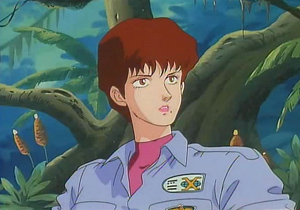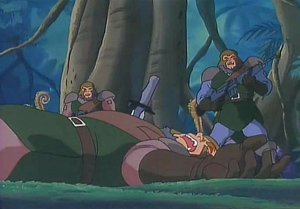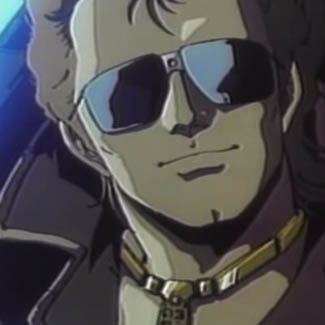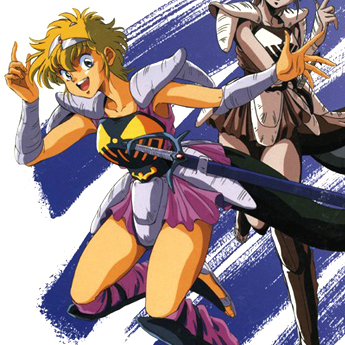
Perhaps it’s just the nostalgia talking, but I believe the eighties were a magical time for anime, when production budgets were padded out by the laughter of unicorns and all the tedious in-betweening was accomplished by teams of mystical pixies high on fairy dust. Then the Japanese bubble economy burst, the unicorns were eaten by wolves, and the pixies went on strike. Long story short: we don’t get works like Garaga anymore.
Garaga, aka Hyper Psychic Geo Garaga, is a story about something. Something that happens. In space. A crew of intrepid so-and-sos set off on an important mission to do something. In space. Then something goes terribly wrong when someone sabotages their space ship, and they crash through a dimensional gate onto some alien planet called ‘Garaga.’ Stuff happens. Stuff blows up. There are robots and dragon-dinosaurs and a race of savage ape-men with guns, and then the heroes team up with some race of psychic aliens and they accomplish… something.
 I’ll admit it. I have no flippin’ clue what’s going on in this movie. There are anywhere between three and a dozen different secret rival factions, all betraying and double-crossing each other, and each one has a different goal in mind. But I’ll be dipped if I know what any of those goals are. And that’s just the way I like it. Because, darn it, in the eighties you didn’t need to have character or plot to get your anime green-lit, you just needed an excuse to have your animators draw orbital death cannons and interstellar colonies blinking away in the vastness of the Milky Way while the synthesizers wail in the background. And if you wanted to rip-off, er, I mean, “pay homage to” various better pop culture properties, ranging from Alien to Terminator to Planet of the Apes, then by God, you could and you did!
I’ll admit it. I have no flippin’ clue what’s going on in this movie. There are anywhere between three and a dozen different secret rival factions, all betraying and double-crossing each other, and each one has a different goal in mind. But I’ll be dipped if I know what any of those goals are. And that’s just the way I like it. Because, darn it, in the eighties you didn’t need to have character or plot to get your anime green-lit, you just needed an excuse to have your animators draw orbital death cannons and interstellar colonies blinking away in the vastness of the Milky Way while the synthesizers wail in the background. And if you wanted to rip-off, er, I mean, “pay homage to” various better pop culture properties, ranging from Alien to Terminator to Planet of the Apes, then by God, you could and you did!
I’m not kidding when I say “no character” here, kids. The whole cast has no discernible traits. The only notable quality of the hero, Jay, is that he’s voiced by Toshio Furukawa, the man who performed such diverse roles as Ataru Moroboshi in Urusei Yatsura, Piccolo in Dragon Ball, and Portugas D. Ace in One Piece. In Garaga, Jay rides a speeder bike, catches the eye of no less than two psychic alien princesses, and wields a weapon known as the battle gear: a shoulder harness-mounted cannon that doubles both as a light saber (DON’T SUE US, GEORGE LUCAS!) and a jet-pack. This would be awesome, but Jay only breaks out the battle gear twice in a movie that is one hundred minutes long. The ultimate antagonist, Alf Dolf—sadly not an amalgamation of the popular furry alien sitcom star and action hero Dolph Lungren—is a deranged android. I know he’s a deranged android, because the exposition tells me so. I thought he was just a normal guy with fiber-optic jugular veins and the voice of Norio Wakamoto.
Did I mention this was made in the eighties?
 In all seriousness, the most interesting characters in Garaga are the sidekick robot, Onbu, and the race of ape-men known as the Umlanga. Onbu is notable for being the most levelheaded character of the cast, in that he’s the only one who reacts to peril in a reasonable way. The human cast members remain as placid as Hindu cows regardless of the horrors that confront them. Sabotaged space craft? No problem. Crash landing into canopy jungle at 800 km/second? No big deal. Stranded on a hostile alien world with no means of sending a distress call? No sweat. The humans don’t even bat an eyelash when an ape-man in imperial armor crushes poor Rin in a mighty bear hug, or when Ann gets stepped on by the Froghemoth that wandered in from of the 1st Edition Dungeons & Dragons Monster Manual II.
In all seriousness, the most interesting characters in Garaga are the sidekick robot, Onbu, and the race of ape-men known as the Umlanga. Onbu is notable for being the most levelheaded character of the cast, in that he’s the only one who reacts to peril in a reasonable way. The human cast members remain as placid as Hindu cows regardless of the horrors that confront them. Sabotaged space craft? No problem. Crash landing into canopy jungle at 800 km/second? No big deal. Stranded on a hostile alien world with no means of sending a distress call? No sweat. The humans don’t even bat an eyelash when an ape-man in imperial armor crushes poor Rin in a mighty bear hug, or when Ann gets stepped on by the Froghemoth that wandered in from of the 1st Edition Dungeons & Dragons Monster Manual II.
As for the Umlanga, the savage race of ape-creatures who travel in helicopters and armored personnel carriers, yet generally fight with swords, well, I feel sorry for them. It’s clear from their few spoken lines that they’d much rather stay inside, enjoying the air conditioning and the experience of not being shot to death with lasers, than continue their role as cannon fodder for the intergalactic imperialists that uplifted their species to sapience.
 I don’t know which is the most remarkable fact: that Garaga was made in 1989 and released as a theatrical feature; that Central Park Media licensed it and released it both on VHS in 1995 and DVD in 2001; or that I finally got around to watching it in 2011. This DVD has sat on my shelf for ten years. And time has not been kind to Garaga, although it did have a pleasant color palette and some decent mechanical design.
I don’t know which is the most remarkable fact: that Garaga was made in 1989 and released as a theatrical feature; that Central Park Media licensed it and released it both on VHS in 1995 and DVD in 2001; or that I finally got around to watching it in 2011. This DVD has sat on my shelf for ten years. And time has not been kind to Garaga, although it did have a pleasant color palette and some decent mechanical design.
Garaga serves as an interesting example of the sort of creative freedom Japanese animators had some three decades ago, when they could throw everything at the wall just to see what would stick. It’s a failure, but an interesting failure in what it says about the history of anime: even during a golden age, there’s plenty of iron pyrite to go around.
Distributor: U.S. Manga Corps
Originally released: 1989
Running Time: 100 minutes







